
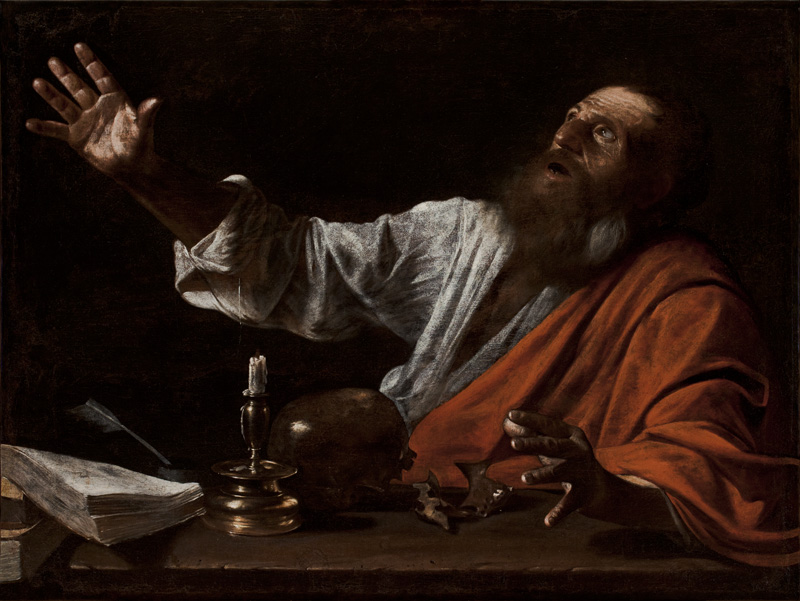
THE VISION OF SAINT JEROME
Follower of Caravaggio
First half of the 17th century, possibly Italian
Oil on canvas
Austin S. Garver Fund, 1960.13
Alternative Labels
St. Jerome, one of the four church fathers, is known for his translation of the Bible from Greek and Hebrew to Latin in the 4th century AD. Despite his religious position he was also fascinated with Roman writings, including Cicero, as he secretly confessed in his letters. This painting depicts the moment when God accuses the church father of reading pagan literature.
Any discussion about the painting's authorship includes one of the foremost Baroque painters, Michelangelo Merisi da Caravaggio (1571 - 1610), as well as other important Italian and northern European artists active in the first half of the 17th century. Some art historians consider it to be an autograph work by Caravaggio, but the attribution remains uncertain. Caravaggio's revolutionary art, as well his moral conduct, made him the most admired and scorned artist during his lifetime. After his death however, he was nearly forgotten until the 1940s when art historians rediscovered his work. Recently, several major international Caravaggio exhibitions provide proof of his greatness and art historical significance.
If not by Caravaggio, this work could only have been painted by an artist who had closely observed the master's work. Caravaggio's use of dramatic lighting or chiaroscuro, and realistic approach to religious subject matter had a strong influence on his contemporaries, such as Ribera, Rembrandt, and Georges de la Tour.
Typically, depictions of the Vision of St. Jerome include angels blowing their trumpets. Here the artist takes an unusual approach and focuses exclusively on the moment that the saint is struck by divine light. Frightened, he shields himself with his right arm, snuffing out the candle and dropping the skull that now rests in broken pieces on the table. The still life can also be read as a memento mori, a reminder of the transitory nature of life.
Art historians continue to search for ways to untangle the mysteries of this Caravaggesque painting with its unusual depiction of St. Jerome.

It is the expression on St. Jerome's face that conveys to me that a new revelation was made (or heard) by this older man. The painter, no doubt, intended the revelation - or new thought, new connection of thoughts - to be linked to the spiritual realm, a moment generated through a connection to the Christian God - perhaps a thought about frailty and aging as the skull on his desk has broken. Depending on one's predisposition about aging, St. Jerome's expression might be interpreted as fear related to old age and death, or it might be seen as active intellectual engagement as ideas about age, spirituality, and other aspects of life are brought together in larger thought about the meaning of life and the period of old age. Despite all of the improvements science, medicine, and social policy have produced related to growing older, in general, most people still dislike it and have a negative image of it. Our ongoing challenge is to see the period of later life as one of growth, of continual enlightenment, and one where duration of life offers meaningful and valuable perspective.

My first thought is that there is nothing in this painting that identifies the subject as the famous Saint Jerome, and if it were meant to be Jerome, there is a universality about this painting that extends to anyone who has a revelation, a vision, a numinous experience. Yes, there is an open book, which at the very least expresses some education. And certainly Saint Jerome was a highly educated linguist and scholar. But the thing that stands out in my mind is that the light has come as a total surprise to him, just as any sudden insight often comes as a total surprise to any of us. His first reaction is to shade his eyes from the light, but the light cannot be blocked. Even the candle is blown out, or was it ever lit? Who knows?

Upon entering the Masters Gallery, I found myself completely mesmerized by The Vision of Saint Jerome. His expression captures so many emotions: surprise, fear and awe. Small details of this painting can be noticed only in person, including Jerome's two bottom teeth, a detail I never noticed in reproductions. These seemingly insignificant elements change how I interpret the figure, unlocking images within my own perceptions and past experiences and allowing me to fall deeper into the atmosphere of the painting.
So, who is Saint Jerome anyway? He was one of the four church fathers, known for translating the Bible from Greek and Hebrew into Latin in the 4th-century CE. The painting depicts the moment when God accuses Jerome of reading pagan literature, including Cicero.
The Vision of Saint Jerome is markedly Baroque, a style similar to Renaissance art, yet much more dramatic. Artists of the 17th century sought to produce true to life creations, bursting with passionate energy and emotion. In using perspective, the artist creates a three-dimensional illusion that draws the viewer into the scene. In addition to perspective, this true-to-life quality was also accomplished through sharp contrasts between light and dark, a technique called chiaroscuro, from the Italian words chiaro, meaning "light", and oscuro, meaning "dark." The combination of dramatic lighting is seen on Jerome's face and right shoulder. But most effective is the light illuminating the palm of Jerome's right hand and his left hand's fingertips. These finely tuned techniques are designed to visually lead the viewer's eye through these points of light and shade in a captivating way.
One of the most provocative details of this masterwork is the mystery that surrounds its author, said to be by one of the followers of Michelangelo Merisi da Caravaggio (1517-1610). Yet, some art historians consider it to be a work by Caravaggio himself, one of the greatest and most influential Baroque painters. Forever infused with mystery, there are more questions than answers when it comes to The Vision of Saint Jerome. Viewing this work takes us beyond the surface if we allow it. Like reading a good book, it transports us to another world.
Alloy Orchestra is a three man musical ensemble, writing and performing live accompaniment to classic silent films. Working with an outrageous assemblage of peculiar objects, they thrash and grind soulful music from unlikely sources. As part of special programming, Alloy Orchestra collaborated with the Worcester Art Museum in December to create two musical labels for artworks in the [remastered] exhibition. The original score produced from this project highlights The Vision of St. Jerome and Veronese's Venus Disarming Cupid and was performed and recorded live at the museum.
The unique experience of creating musical art in a magical space elicits some interesting responses from orchestra members:
“At first, my reaction was "how do you write a soundtrack to a painting?" But as I looked at the two artworks, and read a little about the subject matter, I realized that each of the two paintings represented just one moment in a very dramatic scene. It could be approached like a single scene from a movie soundtrack - with a progression of emotions that develop along with the characters. I felt that the musical accompaniment was an excellent way of focusing the critical gaze of both the audience and the musicians. I personally have a hard time spending 10 minutes just looking at a painting and thinking about it. Having a time-based art, such as music, comment on the painting, helped me keep my mind on the work.” - Ken Winokur
“At first I was a bit apprehensive about accompanying a still painting after years of working with moving images. But once we set up in the gallery and were surrounded by such incredible works of art, it seemed very natural. The paintings and stories behind them were naturals for musical interpretation. Hopefully we'll have the chance to work with WAM again in the future.” -Terrence Donahue
“My primary interest in painting is pre-Renaissance and post-1880, so I was concerned that these paintings were going to pose a problem for me. However, they both had a gripping story and that story became our focus. My interests in mythology and ancient belief systems allowed me to dig into the paintings and feel the underlying ideas. The resulting music felt quite spontaneous and not unlike Alloy Orchestra's work with silent film. I felt the collaboration (WAM/The two painters/Alloy Orchestra) was a pleasurable success.” - Roger Miller
Conservation
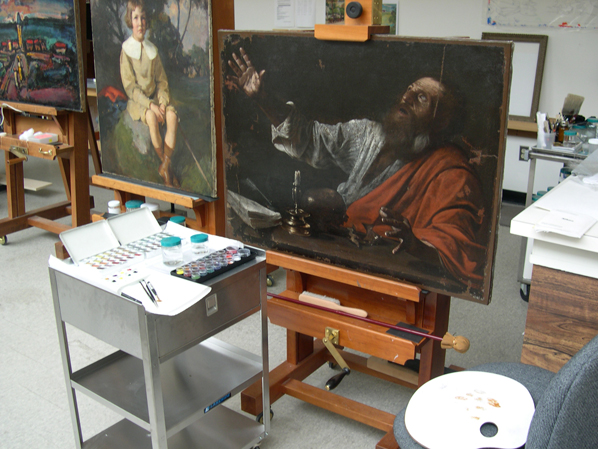
In 1960, when The Vision of Saint Jerome arrived at the Worcester Art Museum, it was attributed to the German artist Johann Ulrich Loth (1599 - 1662). Since that time, art historians have questioned the attribution and assigned the artwork to other European artists, including none other than Michelangelo Merisi da Caravaggio (1571 - 1610). Old restorations that obscured the artist's technique, and the painting's poor condition, made it impossible to firmly attribute the painting.
When I arrived at the Museum from Germany in 2006, this was my first major project as a Conservation Fellow. Working with my colleagues, we performed a technical examination and established a treatment protocol in which I removed old restorations and darkened varnishes, strengthened structural weaknesses and replaced paint loss. It was a challenge to transform the damaged painting to an exhibit-able one, while preserving the artist's intention.
We also hoped to solve the mystery regarding attribution by carrying out technical and iconographical research, reviewing provenance information, and inviting Baroque experts to examine the painting anew. Despite our enthusiasm and intensive research, we could not assign a definite name or region to the work. Nevertheless, this high quality painting is closely associated to works by Caravaggio, such as his David in Rome's Villa Borghese and The Raising of Lazarus in Messina, Italy.
Unfortunately, in some areas the uppermost paint layers are worn away, such as in the beard of the Saint. However, if you look closely at the sleeve, you will find traces of fabulous painting. The artist boldly executed dramatic lights and shadows, while also delicately crafting the loose thread that would have tightened the sleeve around the wrist. He was able to achieve the dramatic foreshortening and distinctive chiaroscuro that is characteristic of Caravaggio's style.
Although, technical examination could not lead us to a name attribution, it did confirm that this high quality work was at least painted by someone closely connected to Caravaggio. Most likely the artist painted St. Jerome and the accessories for the memento mori from life. However, having only fragments of a human skull available, he used animal bones to model the jaw. The artist built up the paint layers over a dark ground in which he scratched incision lines to indicate the design. These lines are visible in the Saint's right arm and beard. You can also detect some changes, or pentimenti, that the artist made on the left index finger and on a skull fragment. Large drying cracks visible in the Saint's clothing indicate that the artist painted on top of paint that was still wet, or he mixed too much binding media in his paint. This phenomenon is found in works by many accomplished artists, even Caravaggio!
Not only attribution and provenance are uncertain -whether or not the painting depicts Saint Jerome (342/7 - 420 A.D.), who was among the most frequently portrayed saints during the Baroque era, remains questionable. Jerome is of significance as he transliterated Greek and Hebrew original text into Latin. On the other hand, according to church history, he was also a bad boy, causing trouble wherever he went. He had to hide on occasions from religious and political enemies and drew criticism for his bold attraction to pagan literature. He evidently based some of his writings on those of the outspoken Roman philosopher and politician Cicero (106 - 43 BCE). In a letter dated 384 AD, Jerome describes a transformative vision in which he was scourged in Heaven for using heathen literature as a basis for his writings. Although he swore off the forbidden literature, modern research proves otherwise.
In our painting, the man is startled by a divine light and, terrified, shields himself. The sudden force has broken apart the skull and extinguished the burning candle. This motif is not fully in accordance with the traditional iconography of Jerome's vision in which he typically faces the Last Judgment. For example, in contemporary works by Ribera, Domenichino and Guercino, angels and trumpets, signs of the Last Judgment, are always present. Since x-radiography proves the canvas is largely whole, there is no reason to believe that parts of the composition are missing; rather this depiction of St. Jerome was an iconographic invention of an innovative artist. Although we don't know where he came from and exactly when he painted this picture, we get the feeling that this artist was a genius.
Take a look in the Worcester Art Museum archives and learn more about your favorite pieces.
Files are in .pdf format. Please allow a few moments to load.
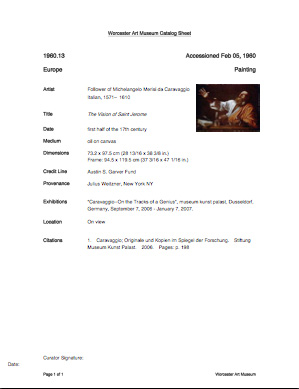
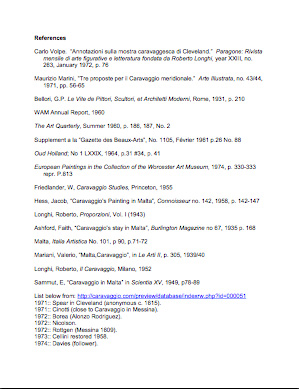
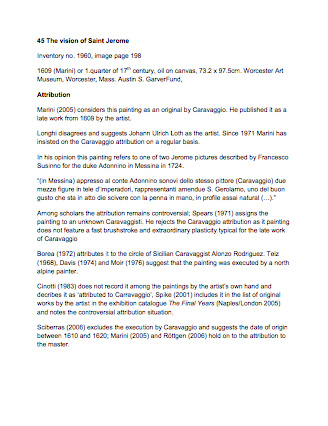
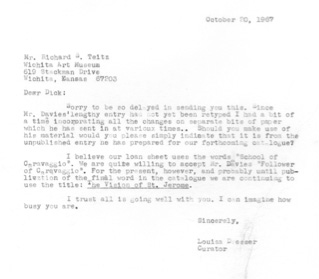
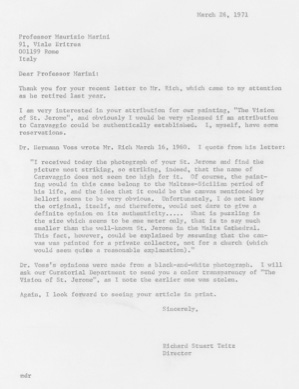
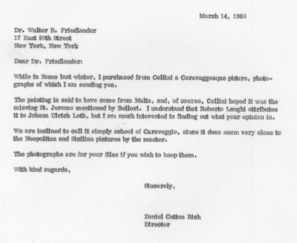
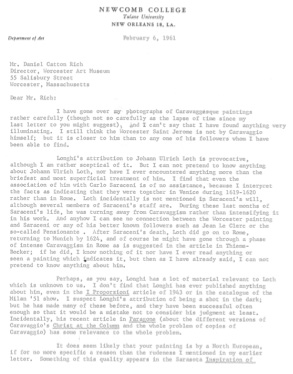
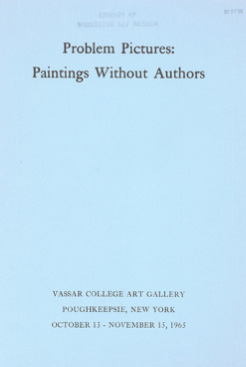

 Sign up for WAM eNews
Sign up for WAM eNews